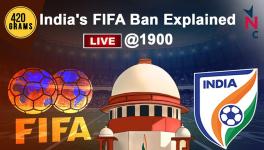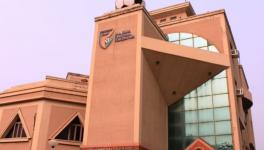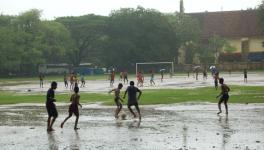All the Details of the AIFF Technical Committee Discussion on May 8

Previously, the AIFF had often said that “rubbing shoulders” with foreigners would give Indian footballers the required confidence to play international football. The theory hasn’t proved to be a huge hit (Pic: Bengaluru FC).
It was a kind of “foreign feast” for us wide-eyed desi soccer fans when the Indian Super League (ISL) kicked off in 2014. For the first time, six foreign footballers were allowed in the starting eleven.
In one of the matches, calculations went awry for a particular franchise while making a substitution. For a few minutes, they had seven foreigners on the pitch before anyone realised. No serious action was taken against them. More the merrier was the slogan for the season!
The quota was reduced to five foreigners after a couple of seasons. I-League clubs also received the “benefit”. Contrary to continental norms for clubs across Asia, three foreigners from any nation plus an additional Asian player, they too were allowed to register six foreigners and play five. The logic was to have a level playing field in the Super Cup, a section in the federation held.
Now, after a few years and several comments regarding how much playing time Indian players are getting, the AIFF’s technical committee has recommended, on Friday, that India move back to the 3+1 rule.
“The Committee discussed at length and unanimously recommended the implementation of the 3 (foreigners) + 1 (Asian) recruit rule for all domestic league matches after the 2021 season onwards, as per current AFC regulations for participation in AFC Club competitions,” said a press release from the AIFF.
Also Read | FIFA Approves Five Substitutions Per Game
This had been the demand of every stakeholder in Indian football (barring a few with vested interest) for a long time. It was good to know the technical committee, headed by former international Shyam Thapa, finally found time to discuss the issue “at length”.
“We all felt the quota should be reduced,” one committee member told this correspondent after the discussions. “It is having a negative impact on Indian football. Because of the presence of foreigners, the pool of Indian players has been reduced to a maximum of 60. The national coach is struggling to find footballers.” He added that the AIFF had already consulted clubs in the I-League and ISL and that all parties were in agreement.
This has been a long time coming. Igor Stimac, the current head coach of the men’s national team, is not the first to lament the lack of playing time for Indian players in key positions.The issue was first raised many years ago by then national coach Syed Nayeemuddin. He was brushed aside. Bob Houghton found the system “poor” but could make little headway. With the ISL, the misery was compounded. Now, finally, it seems there will be some path correction.
The AIFF’s technical director Isac Doru, according to sources, wanted to go a step further. He suggested reducing the quota of foreigners in the I-League, now the second tier, to 2+1. It wasn’t accepted.
Also Read | Sania Mirza: Women Still Have it Tough to Pursue Sport as a Career in India
A source said: “The reduction of foreigners’ quota in domestic football has come from the top. The instruction was to bring down the quota to 3+1 in the next two years. That’s the reason why everyone around was aware of the outcome even before the technical committee could meet.”
Previously, the AIFF had often said that “rubbing shoulders” with foreigners would give Indian footballers the required confidence to play international football. The theory hasn’t proved to be a huge hit. The recent results against Bangladesh and Afghanistan have only dampened the spirit.
Stimac’s critique has helped galvanise this change. In a recent online coaching session with the Sports Authority of India (SAI), Stimac roped in Croatia national coach Zlatko Dalic, who, too, didn’t heap praise on the current system.
Does that mean Stimac is feeling frustrated at the national team front? He didn’t say it in as many words, but his utterances a couple of months ago on lack of strikers in India convey no other meaning. He insisted the number of foreigners has to be reduced.
The Croatian coach is not the favourite of all the technical committee members. At least one of them, who did not pitch for Stimac during his appointment in March 2019, questioned the national team’s performance in Friday’s meeting. He was not to be impressed with the statistics on “series of correct passes” and “accurate positional play”. He wanted results and made no bones about it. It had been discussed before, said chairman Shyam Thapa.
There could be other reasons behind the recommendation of 3+1 rule. The budgetary concerns in the coronavirus-hit market could be one. The uncertainty over availability of foreign footballers in the post-lockdown world could be another.
Also Read | I-League Clubs Terminating Player Contracts Via Force Majeure: The Legal Implications
Moreover, everyone is happy these days. The Asian Champions League slot has been grabbed. The status of the twin leagues has been truly identified. So, perhaps, the time is right to think about development.
There is, of course, many a slip between the cup and the lip. Next season, things could be different, the situation may change. As another committee member suggested, we will only be one more recommendation away from going back on this decision. If, for example, goals in the league dry up the knee-jerk reaction could be to blame it on the lack of quality foreign strikers. Then there is the argument that simply playing two more Indians may not yield the desired outcome. Clubs might still choose to use imported talent in key roles, as they have for long before the ISL. How, then, will Stimac’s problems with the national team be addressed?
These arguments are valid. Changing the number of imports will have an impact, but we will have to see what that might be. In any case it will not happen overnight, or even over the course of one season. Will we have the patience to stay the course?
Get the latest reports & analysis with people's perspective on Protests, movements & deep analytical videos, discussions of the current affairs in your Telegram app. Subscribe to NewsClick's Telegram channel & get Real-Time updates on stories, as they get published on our website.
























